In the competitive digital landscape, the significance of exceptional UI/UX design cannot be overstated. Great design enhances user satisfaction, drives engagement, and boosts conversion rates. In this article, we delve into the best practices for UI/UX design that can elevate your website or application, ensuring it meets the needs of your users effectively.
Understanding UI vs. UX Design
Before diving into best practices, it's vital to distinguish between UI (User Interface) and UX (User Experience) design. UI design refers to the visual components through which users interact with a product, such as buttons, sliders, and icons. UX design encompasses the overall experience users have when interacting with a product, focusing on usability, accessibility, and satisfaction.
1. Prioritize User Research
Successful UI/UX design starts with understanding your users. Conduct surveys, interviews, and usability testing to gather insights into user behaviors and preferences. This information will guide your design decisions and help you create a product that truly meets user needs.
2. Create User Personas
User personas are fictional representations of your target audience based on research. Develop these personas to better understand and visualize the needs, goals, and pain points of your users, which will inform your design direction.
3. Focus on Usability
Usability is a cornerstone of effective UI/UX design. Your interface should be intuitive, allowing users to navigate effortlessly. Key elements include:
- Consistent Navigation: Use familiar and predictable navigation patterns to guide users.
- Clear Calls to Action: Highlight buttons and actions clearly, using contrasting colors and strategic placement.
- Feedback Mechanisms: Provide users with feedback upon interaction to enhance communication and satisfaction.
4. Mobile Responsiveness
With an ever-increasing number of users accessing sites via mobile devices, responsive design is no longer optional. Ensure your UI adapts seamlessly to various screen sizes and orientations while maintaining usability.
5. Visual Hierarchy
Employ visual hierarchy to guide users through your interface. Use size, color, and layout to emphasize critical elements and direct focus, making information easy to digest. A well-organized interface helps users find what they need quickly.
6. Test and Iterate
UI/UX design is an iterative process. Don’t be afraid to test your designs with real users, gather feedback, and refine your approach. A/B testing can help determine which design choices yield the best results.
7. Accessibility Matters
Designing for accessibility ensures that all users, regardless of their abilities, can interact with your product effectively. Follow the Web Content Accessibility Guidelines (WCAG) to make your designs more inclusive, such as:
- Using sufficient color contrast for readability.
- Providing alt text for images.
- Ensuring your site can be navigated using a keyboard.
Conclusion
Implementing these UI/UX design best practices can significantly enhance the quality of your digital products. By prioritizing user research, ensuring usability, and continuously iterating on your designs, you can create extraordinary experiences that resonate with users and achieve your business goals. At Prebo Digital, our team specializes in creating user-centered designs that improve engagement and conversion rates. Contact us to get started on your next project!














